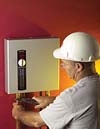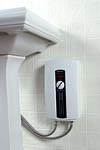Storing hot water is a strange thing to do, when you think about it. In our homes, many of us keep 40, 60, or even 80 gallons of water heated to 130°F or more, 24 hours a day, 7 days a week. When you're away at work, the water's heated. While you're sleeping, the water's heated. Even a well-insulated unit has to heat the water when it's not being used. Yet despite all the energy being used, you can easily end up with a cold shower if you don't have a large enough tank for your needs-but a bigger tank means more water to keep hot all day.
More and more homeowners are asking the question, "wouldn't it make more sense to heat the water only when you need it?"

Types of Systems
Point-of-use systems are most often used in commercial buildings, warehouses, office buildings, malls, restaurants, hotels, gas stations, and schools. These units can be placed right where the hot water is used, eliminating the heat loss that inevitably occurs over long pipe runs.Traditionally, point-of-use systems have appealed to commercial office and industrial environments because they are ideally suited for hand washing locations. Point-of-use units can be installed for home use occasionally when a specific single location function such as a kitchen or laundry faucet is selected. In each case, as the name implies, the point-of-use unit is easily installed directly at the point of use, thus requiring minimal plumbing hook up to a cold water pipe and electrical connections. Stiebel Eltron's DHC series operates at an efficiency level of 98%, saving energy and money.
Whole-house systems can serve multiple points of use far more efficiently than a tank system. These systems utilize the traditional branch-type plumbing system to carry hot water from a central location to the multiple demand locations. A high-capacity model like Stiebel Eltron's Tempra can accommodate kitchen, shower, bathroom faucets, and even hot tub demands. Since there is no tank taking up valuable floor space, a Tempra whole-house unit can be installed at a central location to reduce the distance to the demand locations. With less distance, there is less heat loss through the pipes. In the case of new construction, less piping translates directly to lower construction costs.
The rise in popularity of electric tankless installations is due to factors that go beyond the products themselves. When home owners find themselves waiting for hot water, or when they wish to improve the operational efficiency of their home's hot water system, the tankless option becomes a sound decision. Tankless means never running out of hot water, while operating at an efficiency level near 100%.
Generally speaking, applications in a warm climate work better than those in a cool climate because the ambient water temperatures are higher in a warm climate. With a standard 200-amp electrical service, a tankless electric whole-house heater can supply enough hot water for a multi-bathroom family.

How "On-Demand"
The main components of a tankless system include the heating element, which heats the water as it flows through; the control system, which senses the water temperature and controls the heating element and flow rate; and the control panel, which provides the interface for controlling the system settings.Stiebel Eltron's heating elements are constructed with reliability at the forefront. Each element is encased in a copper coil so it will last a very long time, even under high mineral conditions. Cheaper construction methods leave the element exposed and vulnerable to corrosion-leading to replacement costs and headaches down the road.
Advanced control systems are another hallmark of Stiebel Eltron's systems. The DHC-E series of point-of-use systems, for example, continually monitors the water's temperature and flow rate via several temperature and flow sensors, which feed their readings into the unit's proprietary microprocessor control. The DHC-E heating elements are engaged in stages, achieving precise temperature control under variable conditions.
The complex activities of this control system are concealed by the easy-to-use interface. A digital display, located on the front cover of most models, indicates the selected water temperature between 86°F and 125°F. The water temperature never deviates from the set point.

Key Success Factors
Contractors experienced with on-demand water heating systems say that quality and reliability are far and away the most critical factors in choosing a tankless system. Stiebel Eltron's copper coil provides the most reliable heating element possible, and their precisely engineered control system provides consistent, reliable performance.Care must be taken when choosing the right model for the job. Calculating the capacity you need, while not overly complicated, is a bit different than with tank systems. In addition to expected usage patterns, these calculations take into account factors such as the climate, variations in power supply, and water flow rates. Stiebel's technical advisors can help you make the best decision possible.
For very large residential floor plans encompassing perhaps a kitchen and 3-4 baths, homeowners may find it most economical to install more than one whole-house unit to minimize piping runs, save energy, and avoid water waste.
Stiebel Eltron has developed a series of six Tempra models to accommodate the assortment of variables that determine a particular household's needs. The company also offers a choice of eight different point-of-use models. Stiebel also directs people to consult with the easy-to-read advisory tables on its Web site to help them select the unit that might best suit their particular needs.
Energy Savings and Other Benefits
- A high-quality tankless system can save 20% or more on your electric bill. At a time when energy costs are skyrocketing, that's welcome news to any property owner.
- Stiebel Eltron's systems weigh 5 to 25 pounds and are about the size of a briefcase or smaller, making installation very easy. Without a hefty tank to move, installation becomes a one-person job, reducing labor costs.
- Point-of-use systems eliminate the cost and energy loss associated with long piping runs.
- A centrally located whole-house system connects to your existing branch-type plumbing.
- Without a big tank in the way, you can use your basement, garage, or closet space more productively.
- With a tankless system, the hot water never runs out-even if you have teenagers in the house.
As a leading manufacturer and pioneer of water heating technology in Europe since the 1950s, Stiebel Eltron spends a great deal of time discussing water heating systems with contractors, engineers, and plumbing professionals. As the demand for electric tankless systems in residential applications grows, so has the insistence for trouble-free products. "People want reliability,"